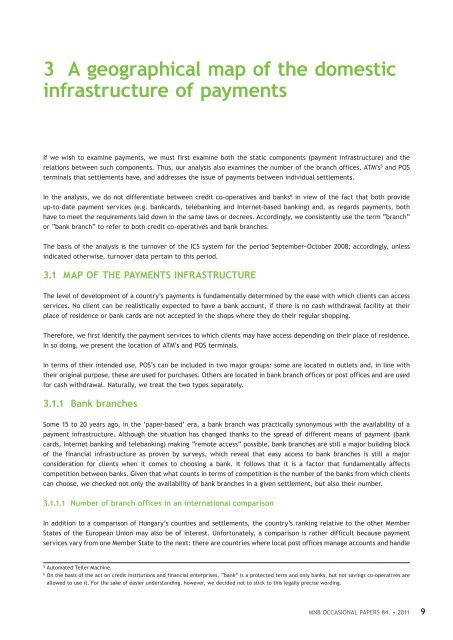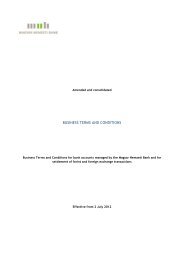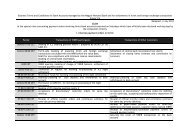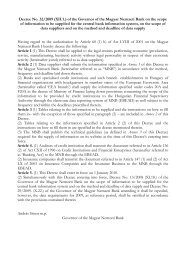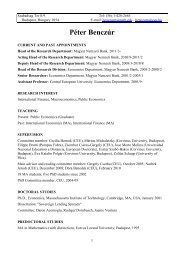The map of payments in Hungary - Magyar Nemzeti Bank
The map of payments in Hungary - Magyar Nemzeti Bank
The map of payments in Hungary - Magyar Nemzeti Bank
Create successful ePaper yourself
Turn your PDF publications into a flip-book with our unique Google optimized e-Paper software.
3 A geographical <strong>map</strong> <strong>of</strong> the domestic<br />
<strong>in</strong>frastructure <strong>of</strong> <strong>payments</strong><br />
If we wish to exam<strong>in</strong>e <strong>payments</strong>, we must first exam<strong>in</strong>e both the static components (payment <strong>in</strong>frastructure) and the<br />
relations between such components. Thus, our analysis also exam<strong>in</strong>es the number <strong>of</strong> the branch <strong>of</strong>fices, ATM’s 5 and POS<br />
term<strong>in</strong>als that settlements have, and addresses the issue <strong>of</strong> <strong>payments</strong> between <strong>in</strong>dividual settlements.<br />
In the analysis, we do not differentiate between credit co-operatives and banks6 <strong>in</strong> view <strong>of</strong> the fact that both provide<br />
up-to-date payment services (e.g. bankcards, telebank<strong>in</strong>g and Internet-based bank<strong>in</strong>g) and, as regards <strong>payments</strong>, both<br />
have to meet the requirements laid down <strong>in</strong> the same laws or decrees. Accord<strong>in</strong>gly, we consistently use the term “branch”<br />
or “bank branch” to refer to both credit co-operatives and bank branches.<br />
<strong>The</strong> basis <strong>of</strong> the analysis is the turnover <strong>of</strong> the ICS system for the period September−October 2008; accord<strong>in</strong>gly, unless<br />
<strong>in</strong>dicated otherwise, turnover data perta<strong>in</strong> to this period.<br />
3.1 MAP OF THE PAYMENTS INFRASTRUCTURE<br />
<strong>The</strong> level <strong>of</strong> development <strong>of</strong> a country’s <strong>payments</strong> is fundamentally determ<strong>in</strong>ed by the ease with which clients can access<br />
services. No client can be realistically expected to have a bank account, if there is no cash withdrawal facility at their<br />
place <strong>of</strong> residence or bank cards are not accepted <strong>in</strong> the shops where they do their regular shopp<strong>in</strong>g.<br />
<strong>The</strong>refore, we first identify the payment services to which clients may have access depend<strong>in</strong>g on their place <strong>of</strong> residence.<br />
In so do<strong>in</strong>g, we present the location <strong>of</strong> ATM’s and POS term<strong>in</strong>als.<br />
In terms <strong>of</strong> their <strong>in</strong>tended use, POS’s can be <strong>in</strong>cluded <strong>in</strong> two major groups: some are located <strong>in</strong> outlets and, <strong>in</strong> l<strong>in</strong>e with<br />
their orig<strong>in</strong>al purpose, these are used for purchases. Others are located <strong>in</strong> bank branch <strong>of</strong>fices or post <strong>of</strong>fices and are used<br />
for cash withdrawal. Naturally, we treat the two types separately.<br />
3.1.1 <strong>Bank</strong> branches<br />
Some 15 to 20 years ago, <strong>in</strong> the ‘paper-based’ era, a bank branch was practically synonymous with the availability <strong>of</strong> a<br />
payment <strong>in</strong>frastructure. Although the situation has changed thanks to the spread <strong>of</strong> different means <strong>of</strong> payment (bank<br />
cards, Internet bank<strong>in</strong>g and telebank<strong>in</strong>g) mak<strong>in</strong>g “remote access” possible, bank branches are still a major build<strong>in</strong>g block<br />
<strong>of</strong> the f<strong>in</strong>ancial <strong>in</strong>frastructure as proven by surveys, which reveal that easy access to bank branches is still a major<br />
consideration for clients when it comes to choos<strong>in</strong>g a bank. It follows that it is a factor that fundamentally affects<br />
competition between banks. Given that what counts <strong>in</strong> terms <strong>of</strong> competition is the number <strong>of</strong> the banks from which clients<br />
can choose, we checked not only the availability <strong>of</strong> bank branches <strong>in</strong> a given settlement, but also their number.<br />
3.1.1.1 Number <strong>of</strong> branch <strong>of</strong>fices <strong>in</strong> an <strong>in</strong>ternational comparison<br />
In addition to a comparison <strong>of</strong> <strong>Hungary</strong>’s counties and settlements, the country’s rank<strong>in</strong>g relative to the other Member<br />
States <strong>of</strong> the European Union may also be <strong>of</strong> <strong>in</strong>terest. Unfortunately, a comparison is rather difficult because payment<br />
services vary from one Member State to the next: there are countries where local post <strong>of</strong>fices manage accounts and handle<br />
5 Automated Teller Mach<strong>in</strong>e.<br />
6 On the basis <strong>of</strong> the act on credit <strong>in</strong>stitutions and f<strong>in</strong>ancial enterprises, “bank” is a protected term and only banks, but not sav<strong>in</strong>gs co-operatives are<br />
allowed to use it. For the sake <strong>of</strong> easier understand<strong>in</strong>g, however, we decided not to stick to this legally precise word<strong>in</strong>g.<br />
MNB OCCASIONAL PAPERS 84. • 2011 9


